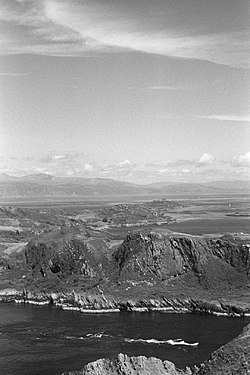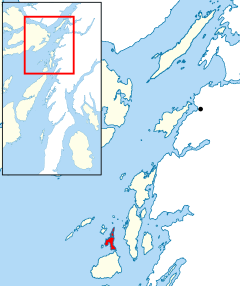Lunga, Slate Islands
| Lunga | |
 Lunga from Scarba with the Grey Dog between | |
|---|---|
| Main settlement: | Rubha Fiola Centre |
| Location | |
| Location: | 56°13’12"N, 5°42’0"W |
| Grid reference: | NM706086 |
| Area: | 618 acres (250 ha) |
| Highest point: | Bidean na h-Iolaire 322 feet |
| Data | |
| Population: | 0 |
Lunga is one of the Slate Islands in the Firth of Lorn, a group of the Inner Hebrides all belonging to Argyllshire found between the mainland coast of Lorn in that county and the Isle of Jura.
The name of Lunga itself is derived from the Old Norse for 'Isle of the Longships', but almost all other place names are Gaelic in origin.
The "Grey Dog" tidal race, which runs in the sea channel to the south, reaches 8 knots in full flood.
Man and fish
This narrow island was never heavily populated and today is bereft of any permanent residents. The main activity is an adventure centre on the northern headland of Rubha Fiola. The surrounding seas are fished for prawns and scallops and there is a salmon farm off the south-eastern shores.
The National Scenic Area of which the island is part, hosts a growing number of outdoor leisure pursuits.[1]
Geography
Lunga is a mile and a half west of the island of Luing also amongst the Slate Islands, and just north of Scarba. The nearest town is Oban some 10 miles’ sailing to the north. The channel to the south, Bealach a' Choin Ghlais (pass of the grey dog), is only 200 yards wide and is scoured by the notorious 'Grey Dog' tidal race which reaches 8 knots when in full flood.[2][3] According to an 1845 description:
... about 1 cable broad, and the stream of water during the greater part of ebb and flood rushes along the narrow pass with much violence. So great is the overfall on the current, that even during moderate tides it is impossible to force a boat through.[4]
This strait is sometimes called the 'Little Corryvreckan]' after its greater cousin, the Corryvreckan between Scarba and Jura just a few miles to the south.[5]
There are numerous islets in the surrounding waters. To the north is the isle of Belnahua and to the north-west are Eilean Dubh Mor and the Garvellachs. Due west there is only Dubh Artach lighthouse between Lunga and the open Atlantic Ocean. At high tide the northern tip of Lunga becomes several separate islets with Rubha Fiola (headland of the tidal island) to the north, then Fiola Meadhonach (middle tidal island), Eilean Ioasal (humble island) and Fiola an Droma (drum-shaped tidal island) closest to Lunga proper. All around are smaller skerries and islets, including Eilean a' Bhealaich (island of the pass), Guirasdeal to the south-west and Fladda to the north.[2]
This complexity of land and sea coupled with the strong tides makes these the most treacherous channels amongst the Hebrides.[6]
The highest point of the island is is Bidean na h-Iolaire (“Peak of the Eagle”) and the main bay is Camas a Mhor-Fhir (Bay of the Giant) to the south which provides an escape route from the Grey Dog. The only other anchorage for passing yachts is at Poll nan Corran (the “Sickle-shaped Pool”), on the east coast, which has a pebble beach.[2]
Geology
Prior to the Pleistocene ice ages Lunga was part of a long peninsula stretching south-west parallel to Kintyre. The Firth of Lorn glacier sliced this peninsula into several islands, including Islay, Jura, Scarba, Lunga, Luing and Seil. Later changes in sea level left raised beaches over much of the west coast[3] and Lunga has several examples.
The bedrock of Lunga comprises a mixture of quartzite, limestone and shale called 'Scarba conglomerate' which predominates to the west and in the tidal islands to the north, with schist and mica-schist to the east. Unlike the other Slate Islands immediately to the north, there is no commercially viable slate on Lunga, although the slate workers of Belnahua made use of the fresh water spring known as Tobar a Challuim-Chille (the "Well of St Columba's Church") north-west of Bidean na h-Iolaire during times of drought. It is a trough, made up of flagstones, which reputedly never runs dry.[2]
History
The legend associated with the Bealach a' Choin Ghlais is part of the same story that surrounds the naming of the nearby Gulf of Corryvreckan (“The Speckled Cauldron”). This is where the Norse Prince Breacan of Lochlann is said to have drowned when his boat sank there, so giving his name to this great whirlpool.[7] (‘Lochlann’ a general Gaelic word for Norway or the Scandinavian homelands) The prince's dog managed to swim to land and went in search of his master. Failing to find him on Jura or Scarba he tried to leap across the strait to Lunga, but missed his footing on Eilean a' Bhealaich which sits in the middle of the channel between the two islands. He slipped into the raging current and drowned as well, giving his own name in turn to the strait where he fell - the 'pass of the grey dog'.[8]
Lunga was mentioned by Donald Monro in his 1549 manuscript Description of the Western Isles of Scotland. He states of "Lunge" that it is:
"three myle of lenthe, twa pairt myle of breadthe, with a paroch kirk, guid main land, inhabit and manurit, guid for store and corn. It possist be M’Gillayne of Doward, in feu fra the earl of Ergile. It is a havin sufficient for Highland galeyis in it, layand from the south-west to northeist in lenthe."[9]
In common with many of the remoter Scottish islands the human population experienced a decline during the late nineteenth and twentieth centuries. The highest recorded number was 29 in 1794, declining to 15 by 1891 and only 5 by 1931. The graves of some of the islanders are to be found in the churchyard at Kilchattan on nearby Luing. Lunga was not permanently inhabited during the 1960s and 70s.[2]
The island today
The island is owned by the family of Torquil Johnson-Ferguson[10] who runs the Rua Fiola adventure centre which caters for parties of school age children. The activities, which include rock climbing and canoeing, also make use of the nearby islets including Eilean Dubh Mor and Eilean Dubh Beag.[11] The rest of Lunga itself, where there are only three houses, is primarily used for grazing animals.[2] In 2001 the island had a population of 7 but in 2011 there were no "usual residents" living there as recorded by the census.
Wildlife
The surrounding seas are fished for prawns and scallops and there is a lease for a salmon farm off the south-eastern shores of Lunga just north of the Bealach a' Choin Ghlais by the islet Sgeir Mhic an Altair. This part of the seabed is also a haven for the rare seafan anemone Amphianthus dohrnii. The kelp Laminaria hyperborea dominates much of the surrounding foreshore[12] in areas not swept by the strongest tides. In some sheltered locations with deeper water there are Crinoid|feather stars including Leptometra celtica and the hydroid Lytocarpia myriophyllum. On land the island is home to otter and red deer. Atlantic grey seals, minke whale, bottlenose dolphin, and harbour porpoise are regular marine visitors. Golden and white-tailed sea eagles are also commonly sighted. The area is of growing importance for various leisure activities including scuba diving[1][11][13] and canoeing.[8]
The island is part of the Scarba, Lunga and the Garvellachs ‘National Scenic Area’, which extends to 1,900 hectares,[14] and of the Firth of Lorn marine Special Area of Conservation.[13]
Pictures
-
Lunga's raised beaches
-
On the 'Kiwi' climb at Rubha Fiola
-
A bumpy ride around Lunga
References
- Location map: 56°13’0"N, 5°42’0"W
- ↑ 1.0 1.1 Howson, C.M., Mercer, T. and Moore, J.J. (2006). Site Condition Monitoring: survey of rocky reefs in the Firth of Lorn marine Special Area of Conservation. =Commissioned Report No.190.. Inverness: Scottish Natural Heritage. http://www.snh.org.uk/pdfs/publications/commissioned_reports/f05ac701.pdf. Retrieved 2007-07-28.
- ↑ 2.0 2.1 2.2 2.3 2.4 2.5 Haswell-Smith, Hamish (2004). The Scottish Islands. Edinburgh: Canongate. ISBN 1841954543.
- ↑ 3.0 3.1 Murray, W.H. (1973). The Islands of Western Scotland. London: Eyre Methuen.
- ↑ Whirlpool Scotland Retrieved 26 February 2007. This source is quoting Gillies, Patrick H. (1909) NetherLorn - Argyllshire and its Neighbourhood. London. Virtue & Co.
- ↑ "Dive trip to Correyvreckan". Archived from the original on February 12, 2006. http://web.archive.org/web/20060212124445/http://www.bsactravelclub.co.uk/reports/corryveckan.htm. Retrieved 2007-02-24.
- ↑ Murray, W H (1977) The Companion Guide to the West Highlands of Scotland. London. Collins.
- ↑ "Whirlpool-scotland" (Word). http://www.whirlpool-scotland.co.uk/images/whirlpool/islands.doc. Retrieved 2007-02-25.
- ↑ 8.0 8.1 "Sea kayak guide". http://www.ukseakayakguidebook.co.uk/jura_easter_04/art_jura_easter_2004.htm. Retrieved 2007-02-26.
- ↑ Monro (1774) No. 31
- ↑ "Lunga". Who Owns Scotland?. Archived from the original on January 19, 2004. http://web.archive.org/web/20040119001444/http://www.whoownsscotland.org.uk/page_cache/ar/lunga_rubha_fiola_small.htm. Retrieved 2007-02-24.
- ↑ 11.0 11.1 Rua Fiola Island Exploration Centre Retrieved 26 Feb 2007.
- ↑ Ocean zone definitions Retrieved 1 Mar 2007
- ↑ 13.0 13.1 "Argyll Marine Special Areas of Conservation". http://www.argyllmarinesac.org/DS_firthoflorn.htm. Retrieved 2007-02-26.
- ↑ "Scarba, Lunga and the Garvellachs National Scenic Area". Scottish Natural Heritage. http://gateway.snh.gov.uk/portal/page?_pageid=33,502394,33_502425&_dad=portal&_schema=PORTAL&PA_CODE=9147. Retrieved 2007-07-28.
- Monro, Sir Donald (1549) A Description Of The Western Isles of Scotland. Appin Regiment/Appin Historical Society (1774)
- Munro, R W (1961) Monro's Western Isles of Scotland and Genealogies of the Clans. Edinburgh and London. Oliver and Boyd.
| The Slate Islands |
|---|
|
Belnahua • Easdale • Fladda • Luing • Lunga • Seil • Shuna • Torsa |



